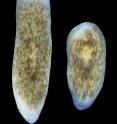Gene discovered that activates stem cells for organ regeneration in Planarians
Researchers announced the discovery of a gene zic-1 that enables stem cells to regrow a head after decapitation in flatworm planarians. Professor Christian Petersen and Ph.D. student Constanza Vásquez-Doorman of Northwestern University discovered zic-1 by investigating planarians, an animal that uses pluripotent stem cells to regrow any missing tissue lost from injury. The study, entitled "zic-1 Expression in Planarian Neoblasts after Injury Controls Anterior Pole Regeneration," was reported in PLOS Genetics.
Many species across the animal kingdom have the ability to regenerate, but the mechanisms that connect injuries to stem cell activation and the production of new tissues are not fully understood. Developmental biologists have established that in the early embryo most animals use "tissue organizers" that secrete proteins to allow cell-cell communication for the formation of organs. But it was not clear how such tissue organizers could be produced from scratch to allow adult regeneration in animals like planarians.
A clue to the solution came from Petersen's previous research that identified the secreted protein Notum as a component of a tissue organizer needed for head regeneration in planarians. Notum drives head regeneration by inhibiting Wnt signaling, a broadly used molecular pathway used in cell-cell communication. Vásquez-Doorman and Petersen found that expression of the Notum protein and head regeneration required the zic-1 gene, which encodes a DNA-binding protein activated in stem cells early after decapitation.
Human stem cells could ultimately be used to build or repair complex tissues, but most ongoing research on these cells has focused on their ability to create individual cell types in a dish. Petersen's study identifies a potentially ancient connection between Wnt signaling and zic-1 in the use of stem cells for coordinating regenerative growth and suggests that human stem cells might someday be used to create tissue organizers for enhancement of injury repair.
